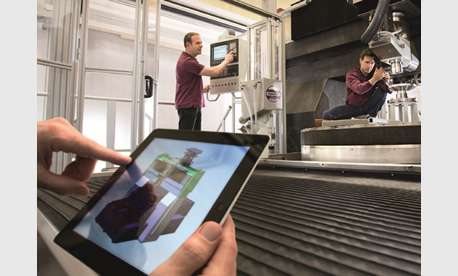Highly precise mirrors for in-depth insights into space

Thanks to simulation and control technology from Siemens, astronomers will be able to gaze even further into space in the future. According to the current issue of the Siemens research magazine Pictures of the Future, the optic surface polishing machine UPG 2000 CNC boasts a unique feature: it enables the standardized production of meter-wide and extremely precise mirror segments for gigantic telescopes.
The UPG 2000 CNC makes it possible to achieve the highest possible precision when it comes to grinding, lapping, and polishing astro-optical equipment. The mirror surfaces must be processed to tolerances within several hundredths of a micrometer. In order to achieve such precision, all of the steps of the work process are carried out within one machine, so that the workpiece does not have to be moved and readjusted. A Sinumerik CNC control system from Siemens carries out the automatic iterations of grinding, polishing, and control measurement by means of highly precise movements of the tools and measuring instruments. The UPG 2000 CNC was developed by OptoTech Optikmaschinen GmbH.
The UPG 2000 CNC could make it possible to avoid an anticipated bottleneck in the supply of large telescope mirrors. Gigantic telescopes are being planned all over the world, and all of the planners are potential customers. However, the delivery time for the hexagonal mirror segments, which can be up to two meters in size, is several years.
If telescopes are to be able to register signals coming from regions of space that are 13 billion light-years distant, as planned, they need special mirrors that are not only very large but also extremely smooth. Otherwise, the weak rays of light would be too widely scattered and the detector would not be able to distinguish them from background noise. In order to ensure that the UPG 2000 reaches precisions of 30 nanometers, the mecatronic experts at Siemens initially constructed and tested the machine virtually. For this purpose, they used the PLM software NX as an integrated software solution. The simulations enabled them to precisely work out key variables such as temperatures and vibrations and the needed rigidity of certain machine components.
For example, transversal oscillations were predicted in a modal analysis, and as a result the granite base was further strengthened as a precaution. The machine is about five meters high and five meters wide and weighs approximately 80 tons. The virtually tested, precise interaction of Siemens drive systems with the Sinumerik control system makes it possible to position the tools and the measuring instruments along all of the axes of motion in a way that is absolutely synchronous and accurate to a tolerance of a few micrometers. The control parameters for all the steps of the work process were developed on the model and then transferred to the machine. These starting settings have considerably simplified the commissioning of the UPG 2000.
Provided by Siemens





















